Nonprofit email examples: Inspiration before your next send
Email is the single most important channel for nonprofits and associations. You likely already know this, which is why you’ve landed here — in the right place.
At Feathr, we’ve partnered with over 1,500 nonprofits to help them know, grow, and engage their audiences with easy-to-use advertising, email, and digital engagement tools.
We work with incredible nonprofits every day who are making the world a little better one email at a time, so we’re excited to share with you some of their amazing work.
Emails can do a lot of things, and part of their power is the ability to relay stories. Julia Campbell, host of Nonprofit Nation, says, “Stories raise more money, more awareness, more reach and engagement than any other form of content.”
We’ve seen three types of stories work especially well when told through email:
- Impact stories
- Participation stories
- Stories of need
Let’s dive in and look at some incredible nonprofit email examples!
1. Impact stories
Impact stories are hard to do well. Julia Campbell has even seen some organizations kick back because it can initially feel emotionally manipulative to tell the stories of the lives you’ve changed. But this is what your organization is ultimately about: changing the world — one life at a time.
There are effective ways to tell this story, and as long as you offer everyone in the story dignity and tell it truthfully, it’s not manipulative. Or at least it isn’t bad manipulative.
This video from charity: water makes me cry every single time. Is that manipulative? Maybe, but I love it! Also, this video from charity: water partially includes all three kinds of stories: need, impact, and participation.
But we’re talking emails today, not video! So let’s take a look at two impact story emails that were highly impactful!

GiveLocal757 is a yearly donation drive for the entire Hampton Roads community in Virginia. And the day is one of the most important days of the year for Peninsula Community Foundation (PCF), which is committed to bringing about positive change in their community.
During the campaign, they sent an email every day of the week leading up to one big ask on the day of GiveLocal757. But each email wasn’t the same story, instead they highlighted six different local nonprofits and the impact they each had on local community members.
To put it mildly, the campaign was wildly successful. PCF already had a large email list and had been invested in the community for a long time, but at the heart of the success was an incredible storyteller, Tammy, writing the emails. The campaign was actually so successful that we want to show you yet another great impact story from that week of incredible emails.

2. Participation stories
There are a ton of different ways that people can participate with your organization. Maybe they simply attend your annual event. Maybe they give sporadically. Maybe they volunteered in the past.
Inviting people into your community and cause is a big part of the story you’re telling. Your organization is at work changing the world, but it takes a village. Let people know how much they mean to you and make sure they know how to get involved.
The first example comes from the Japan-America Society of Washington DC (JASWDC), which throws the largest Japanese street festival in the U.S. each year. They want people to know about this incredibly fun event and to meet them there. And they built absolutely beautiful emails inviting people to participate.

This first email announced dates and offered a discount for registering through the email. Not bad ideas to include in a participation email!
The email gives a clear picture of what to expect from the event, it’s well branded, colorful, which makes it just a great example of how to get the word out about ways people can get involved.
And their emails are so beautiful, I couldn’t help myself from sharing one more.

This email went out much closer to the event to take advantage of last-minute registrants. In today’s environment, people are making decisions much closer to the day of the event, so making sure to send a timely email as the event approaches can make a huge difference.
An entirely different example comes from the Palmetto State Teachers Association (PSTA), which drew inspiration from its print collateral to invite lapsed members to jump back into membership.
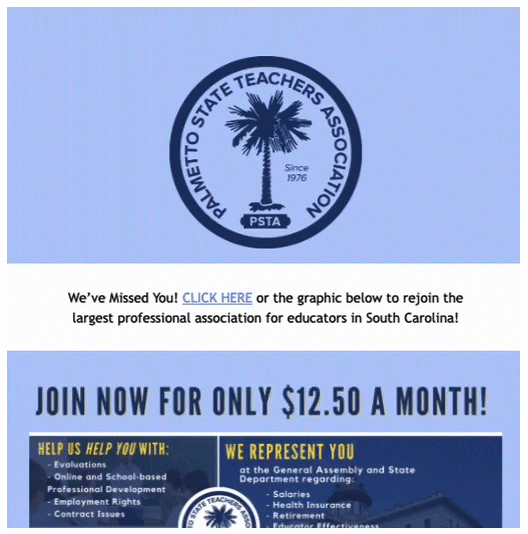
The email is simple, but it’s clear and on brand. People who had already been members knew the benefit of being a part of PSTA, so they didn't need a long email explaining everything. Something simple was all they needed, and it did the trick!
Our last example of a participation email comes from The Food Bank for Central & Northeast Missouri (The Food Bank). It keeps their supporters updated about new developments and invites them to attend an event around the opening of their new central pantry.
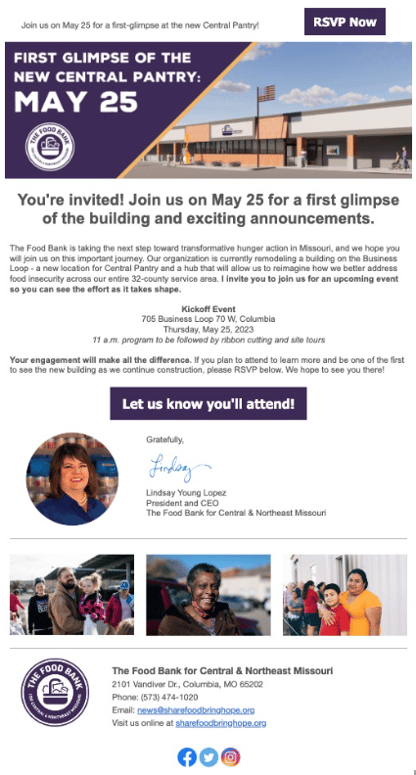
This email is great because it packs a lot of information about who they are and what they’re about. The pictures of people really connect you to what they’re doing and build excitement for their expansion.
3. Stories of need
All three of these types of stories have some overlap as one of the ways people can participate with a nonprofit is through donations. But stories of need are a unique angle that emails can take, showing readers the opportunity they have to make a difference.
This shouldn’t be the only story your organization tells as stories of impact, thank you’s, and invitations should likely be the majority of your email volume. But a well written story explaining how great the need is for your organization’s work can go a long way.
Here’s another examples from The Food Bank because they do a great job explaining their work fighting hunger.
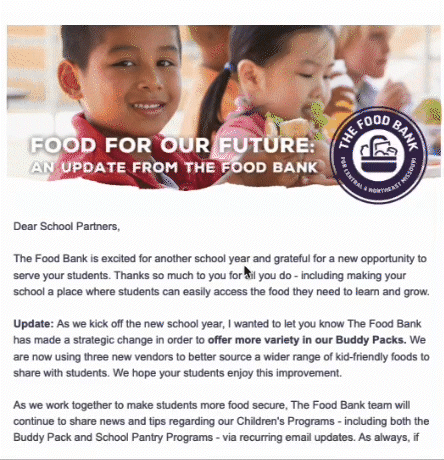
The email provides information about their programs and invites people to learn more about how they can take action to help. It’s simple and educational, but it’s emotionally compelling. It’s a great example of showing how to communicate need.
As you can already tell, we’re big fans of The Food Bank, and they did an incredible job on a matching donation drive. By explaining a need, but also including a limited time frame where a donation could make an even bigger impact, they were able to get tremendous support very quickly.
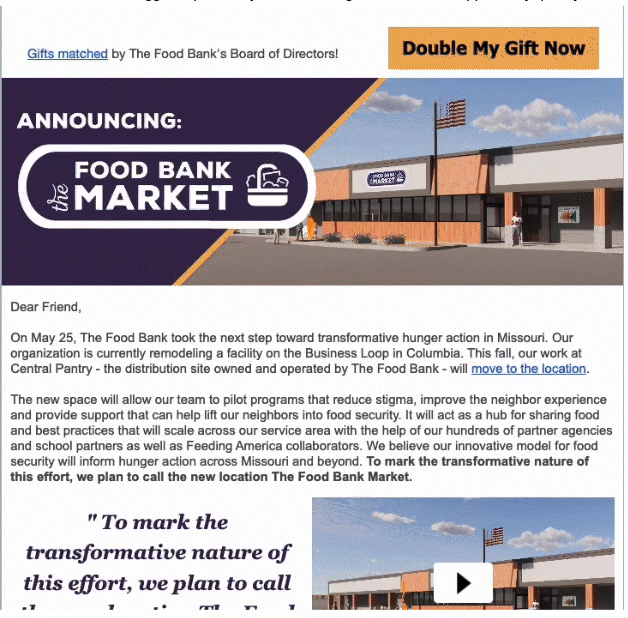
Hunger is a clear need that requires immediate attention. But your cause matters too. Explaining the cost of not being able to expand and not being able to reach your community is a part of you telling the whole story.
We do recommend not focusing always on the need as it can be emotionally taxing. But there are real problems in the world that you’re focused on solving, and your email recipients need to know what it costs the world for them to stay on the sidelines.
Bonus: Follow up emails
This is a lot like participation emails, but the way that this arrives in inboxes is a little different, so we wanted to create a special section for this example.
Have you ever made it to a donation page or a registration page but you ended up not signing up or donating that very moment. This probably happens a lot more than you’d like for it to. But with the right email service provider, you can now send an email as a follow up when someone makes it all the way to that final page but fails to take an action.
You’ve likely had this happen to you through digital ads, and this can be incredibly effective for nonprofits too. But the same idea holds for getting an email in an inbox at the right time for that person.
Here’s an example from a YMCA who wrote a great email to recapture these people who already expressed interest in joining.
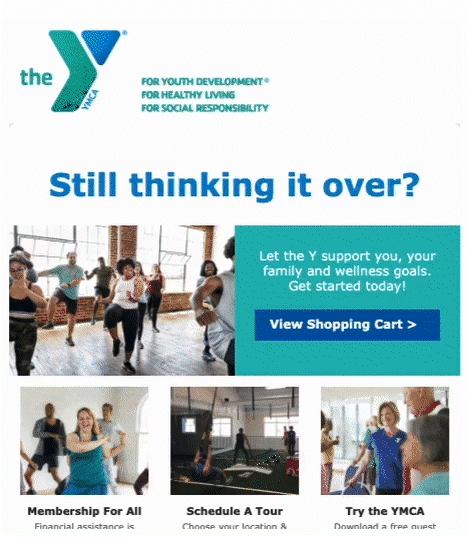
A few takeaways
Email is a uniquely effective way to tell the story of your organization. Sharing the incredible stories of the work you do, inviting people into those stories or into your community, and sharing the need that still exists is key when building your next email.
Stories are so important because they ultimately are a way to connect to your audience. Instead of approaching email marketing or marketing in general through the lens of your own organization, the best marketing is about building authentic connections to the people who have the same mission as you.
The small things also matter in email. Keeping it on brand visually and writing in a conversational way go a long way. But if you’re looking for more tips on how to take your email marketing to the next level, we have a complete guide on the subject.
We hope these examples inspire you as you jump into that next email. We know how hard it can be to hit send once it is ready to go. But we think the world needs to hear your story, so once you've done that hard work of telling your incredible story, just click send!
Share this
You May Also Like
These Related Stories

Nonprofit email marketing: A complete guide
![[Blog]-AssociationEmailMarketing-FeaturedImage-1000x500](https://www.feathr.co/hs-fs/hubfs/%5BBlog%5D-AssociationEmailMarketing-FeaturedImage-1000x500.png?width=1000&height=500&name=%5BBlog%5D-AssociationEmailMarketing-FeaturedImage-1000x500.png)
Association Email Marketing: A Complete Guide

.png?width=150&height=63&name=Feathr%20Logo-Main%20(1).png)
